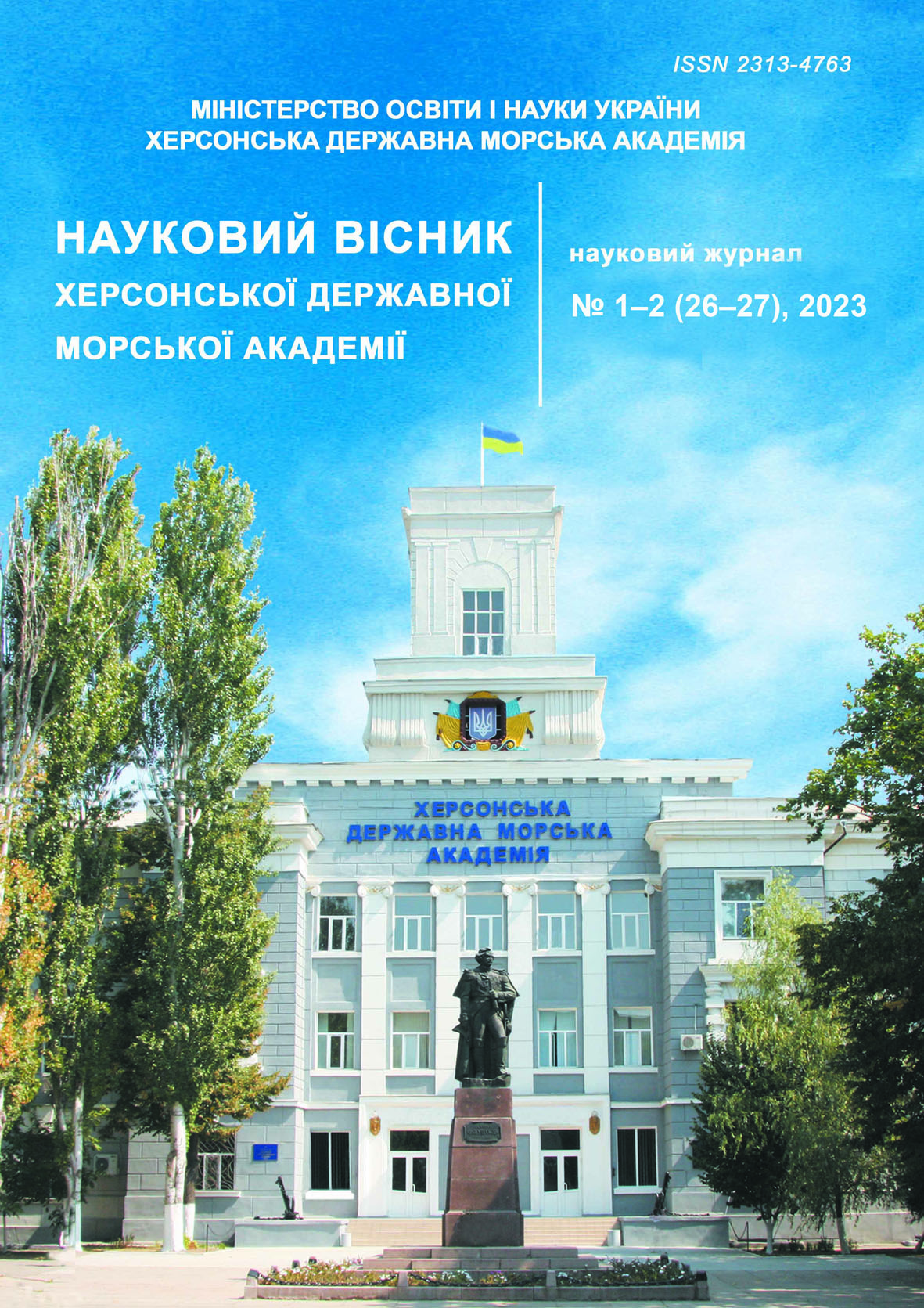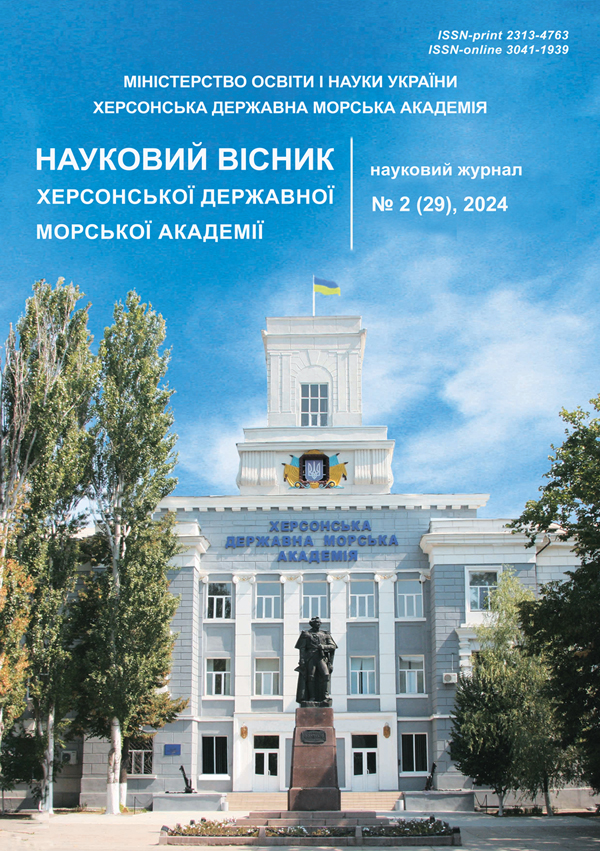SYSTEM FOR MEASURING DYNAMIC CHARACTERISTICS OF AN UNMANNED VESSEL AS A COMPONENT OF ITS AUTOMATIC CONTROL SYSTEM
https://doi.org/10.33815/2313-4763.2024.2.29.049-057
Abstract
The development of modern automatic control systems for unmanned vessels is an important direction for ensuring the efficiency and autonomy of their operation. These systems aim to reduce human intervention while enhancing operational capabilities. One of the important elements of such systems is a dynamic characteristics measurement system, which can provide accurate monitoring and analysis of the vessel’s movement. This system enables real-time feedback on the vessel’s performance and trajectory. The article discusses the task of increasing the efficiency of unmanned vessel control by creating a measurement system for dynamic characteristics. The proposed system uses a GPS receiver to enhance positional accuracy and multi-axis motion sensors, including accelerometers, magnetometers, and gyroscopes, to collect precise data on the vessel’s movement. Specialized algorithms process the sensor data to determine dynamic parameters such as speed, acceleration, and orientation. These parameters are essential for maintaining control over the vessel's movement and improving overall efficiency. The system’s ability to operate in sea conditions is emphasized, as it can provide a high data update frequency for real-time trajectory correction. This ensures the vessel remains on course even in challenging environments. The implementation of the system into the MATLAB Simulink environment allows for real-time visualization and data analysis. The system’s data filtering and correction processes are detailed, showing how parameters are fine-tuned for optimal performance. Particular attention is paid to algorithms for calculating angular positions, accelerations, and speeds, which are crucial for the precise control of the vessel in autonomous mode. These algorithms enable the vessel to adapt to dynamic environmental changes and ensure stability during operation. The results of the study form the basis for further improvement of automatic control systems for unmanned vessels, which opens up the possibility of their widespread use in various tasks, in particular for monitoring, patrolling and maintenance of marine facilities.
References
2. Zhao, Y., Fenglei, H., Duanfeng, H., Xiao, P., Wangyuan, Z. (2022). Decision-making for the autonomous navigation of USVs based on deep reinforcement learning under IALA maritime buoyage system. Ocean Engineering. 266 (5), 112557.
3. Zheng, Y. B., Fan, W. X., Han, M. Y. (2021). Research on multi-agent collaborative hunting algorithm based on game theory and Q-learning for a single escaper. Journal of intelligent fuzzy system. 40 (03), 1–15.
4. Gongxing, Wu, Taotao, Xu, Yushan, Sun, Jiawei, Zhang (2022). Review of multiple unmanned surface vessels collaborative search and hunting based on swarm intelligence. International journal of advanced robotic systems. 19 (2), 1–20.
5. Sun, X., Wang, G., Fan, Y. (2019). A formation collision avoidance system for unmanned surface vehicles with leader-follower structure. IEEE Access. 7, 24691–24702.
6. Tan, G., Zhuang, J., Zou, J. (2021). Coordination control for mul-tiple unmanned surface vehicles using hybrid behavior-basedmethod. Ocean Engineering. 232, 109147.
7. Wei, G. A., Zhang, J. Q. (2024). Research on formation navigation of USV based on improved A* and DWA fusion algorithm. Journal of computational methods in sciences and engineering. 24 (4–5), 3191–3209.
8. Zhou, C., Gu, S., Wen, Y. (2020). The review unmanned surface vehicle path planning: Based on multi-modality constraint. Ocean Engineering. 200, 107043.
9. Tao, Y., Du, J., Lewis, F. L. (2024). Integrated intelligent guidance and motion control of USVs with anticipatory collision avoidance decision-making. IEEE Transactions on intelligent transportation systems. 25 (11), 17810–17820.
10. Rybczak, M., Lazarowska, A. (2024). The development of algorithms for safe control of an autonomous ship. International journal of electronics and telecommunications. 70 (4), 997–1003.
11. Zhu, F., Shen, Y., Wang, Y., Jia, J., Zhang, X. (2021). Fusing GNSS/INS/Vision with a priori feature map for high-precision and continuous navigation. IEEE Sensors journal. 21 (20), 23370–23381.
12. Guo, M. Z., Guo, C., Zhang, C. (2021). SINS/GNSS-integrated navigation of surface vessels based on various nonlinear Kalman filters and large ship dynamics. Journal of electrical engineering & technology. 16 (1), 531–546.
13. Guo, M., Zhou, X., Guo, C., Liu, Y., Zhang, C., Bai, W. (2024). Adaptive federated filter–combined navigation algorithm based onobservability sharing factor for maritime autonomous surface ships. Journal of marine engineering & technology. 23 (2), 98–112.
14. Wang, Q., Zhang, M. (2022). Inertial navigation system gyroscopic on-line calibration assisted by marine star sensor based on forgetting factor selection of a Sage-Husa filter. Journal of marine engineering & technology. 21 (1), 1–8.
15. Zitouni, F., Maamri, R., Harous, S. (2019). FA–QABC–MRTA: asolution for solving the multi-robot task allocation problem. Intellig service robot. 12 (4), 407–418.
16. Tang, H., Yin, Y., Shen, H. (2022). A model for vessel trajectory prediction based on long short-term memory neural network. Journal of marine engineering & technology. 21 (3), 136–145.
17. Liu, J., Achurra, A., Zhang, C., Bury, A., Wang, X. (2024). A long short term memory network-based, global navigation satellite system/inertial navigation system for unmanned surface vessels. Journal of marine engineering & technology. 23 (1), 1–13.
18. Burunina, Zh. Yu., Voitasyk, A. M., Aloba, L. T., Korytskyi, V. I., Sirivchuk, A. S., Klochkov, O. P. (2018). Experimental study of group control laws for an autonomous unmanned underwater vehicle as a group agent. Shipbuilding and marine infrastruture. №2(10), 116–126.
19. AN5192: application note LSM6DSO: Always-on 3D accelerometer and 3D gyroscope. URL: https://www.pololu.com/file/0J1900/dm00517282-lsm6dso-alwayson-3d-accelerometer-and-3d-gyroscope-stmicroelectronics.pdf (дата звернення: 15.01.2025).
20. Aghamirbaha, E., Toloei, A., Alizadeh Roknabadi, M. H. (2022). Analysis of marine navigation methods and systems. 20th International conference of Iranian Aerospace. 1–6.
21. Liu, W., Chen, S., Hu, Y., Lou, N., Wang, S. (2024). Enhancing USVs navigation based on minimum error entropy of GPS vector tracking. Measurement science and technology measurement science and technology. 35 (7), 076307.






